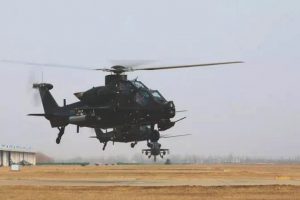Pakistan may procure an upgraded export version of the Changhe Aircraft Industries Corporation (CAIC) Zhishengji-10 (Z-10) attack helicopter for service in the Pakistan Army Aviation Corps (PAAC) according to its commander, Major General Syed Najeeb Ahmed.
Speaking at the IQPC International Military Helicopter conference in London, Ahmed said that the CAIC Z-10ME “remains an option” for the PAAC. “We are looking at other options,” he was quoted as saying by Flight Global on February 26. “One of them is in China in the shape of the new attack helicopter they have created called the Z-10ME. In case the first two options [the AH-1Z Viper and the T129] do not materialize this third option will be considered.”
In April 2016, Bell announced that it would sell 12 AH-1Z Vipers to Pakistan. The U.S. State Department had approved the sale of 15 AH-1Z Vipers and associated equipment at an estimated cost of $952 million to Pakistan in April 2015. While the first rotorcraft were expected to be handed over to the PAAC by mid-2017, no delivery has taken place to date due to deteriorating U.S-Pakistan relations.
The Pakistani government and Turkish Aerospace Industries (TAI) also signed a contract for the sale of 30 T129 multirole attack helicopters in 2018. Both the T129 and AH-1Z Viper are powered by the U.S.-made LHTEC CTS800–4A turboshaft engine. The United States, however, has so far refused to grant U.S. export licenses for the engine. Delays in the development of an indigenous Turkish engine for the helicopter has prevented deliveries of the helicopter gunships.
PAAC conducted extensive trials with the T129 and the Z-10. At the end, the T129 prevailed over the Z-10 principally due to the weak performance of the latter’s WZ-9 turboshaft engine, which reportedly prevented the Z-10 from carrying its maximum weapons payload during military operations.
China has been working on a more powerful engine, the WZ-16, which has reportedly not entered serial production yet. There is also no concrete indication that any Z-10s have been fitted with this more powerful engine. As I explained earlier this week:
The tandem-seat Z-10 took to the sky for the first time in 2003 and has been supplied to at least five PLA aviation regiments. In 2016, the PLA announced that all of its ground force aviation units have been equipped with the Z-10.
The Z-10, co-designed by Kamov Design Bureau of Russia and the Chinese 602nd Aircraft Design Institute, is designed primarily for anti-tank warfare. It can be armed with AKD-9 or AKD-10 anti-tank missiles, rocket pods, and carries an under-nose turret for a 23-millimeter or 30-millimeter cannon. It also has a secondary air-to-air capability and can carry the TY-90 air-to-air missile.
Chinese state-owned media released images earlier this month showing the Z-10 fitted with new engine exhaust outlets, pointing to the existence of a new upgraded variant of the attack helicopter.

































